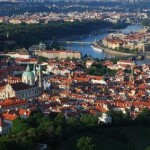Prague Castle
Photo/Submitted
By Victor Block
Part one of a two-part series
Most visitors to the Czech Republic confine their stay to Prague, and with good reason. Known as “the city of a hundred spires,” although it’s actually decorated by nearly a thousand towers and steeples, it challenges the most magnificent capitals of Europe in its beauty, and boasts a history that stretches back over a millennium. In addition, since the Middle Ages Prague (Praha) has been recognized as one of the most vibrant cultural settings on the continent.
Little wonder that the city was ranked fifth in the TripAdvisor 2014 list of best destinations throughout the world. That claim to fame was based in part on its collection of major museums, numerous theaters, and hundreds of concert halls, galleries and other arts and entertainment venues.
During my recent visit to the Czech Republic, I spent three days exploring and enjoying a number of Prague’s major attractions, and could have stayed much longer. That splendid city overwhelms visitors with its architecture, which provides a feast for the eyes, then envelopes them in an aura of living history. Just when you think you’ve seen the most majestic building possible, you turn a corner and come upon another gem that surpasses it in grandeur.
It’s rare to find an architectural treasure trove as rich and varied in such a compact area. The profusion of ancient palaces, castles and cathedrals creates a rich mosaic of outstanding masterpieces in styles that stretch back over 1,000 years. Romanesque chapels stand in the shadow of soaring Gothic cathedrals. Baroque palaces are neighbors to late 19th-century Art Nouveau buildings and examples of the early 20th-century Cubist style.
As a result, it’s easy to understand why the entire city center has been designated as a UNESCO World Heritage Site for its cultural and physical importance. The fact that its buildings survived World War II remarkably intact, unlike many throughout Europe, adds to its appeal.
Few cities have major sites, – and sights – in the number and diversity of those that await exploration by visitors to Prague. At the same time, strolling through its hidden back streets and off-the-beaten-path neighborhoods provides introductions to very different, yet no less enticing, attractions.
The 13th century “Old Town” (Stare Mesto) consists of a labyrinth of winding alleys and picturesque squares, as does the not-quite-so-old “New Town” (Nove Mesto), which dates back to 1348.
A famous landmark in the Old Town’s central square is an imposing tower which has looked out over the setting for nearly seven centuries. A crowd of both visitors and city residents gathers each hour from dawn to dark to watch the 15th century astronomical clock put on its brief but impressive show. A small door opens and a miniature statue of Christ marches out followed by his disciples, as the skeleton of death tolls the hour on the clock’s bell.
The Lesser Town (Mala Strana), also known as the Little Quarter, is clustered around the foothills on which the Prague Castle is perched. The neighborhood was born in the eighth century as a market settlement. Its cobbled streets are lined by small shops, traditional restaurants and pubs, and restored ancient buildings.
The sprawling Prague Castle, which claims the title of the largest medieval castle complex in the world, dates back to 880 A.D. It served as the seat of power for a parade of kings and emperors, and today is the official residence of the president of the Czech Republic.
The castle buildings and courtyards sprawl over an area of 18 acres. In addition to four palaces, there are other residences, cathedrals and churches, defensive towers and several museums with collections of art, toys and historic artifacts.
A ditch that encircles the castle, which was dug to provide added protection, is called the Deer Moat, named for the animals that early rulers kept confined there. Adding color to the setting are six terraced gardens, including the Renaissance Garden which was laid out in 1534.
Those plantings provide only a hint of more than 200 gardens and parks that are dotted throughout the city. The oldest were founded in the Middle Ages and were attached to monasteries, palaces or houses of the wealthy.
Another must-see for visitors to Prague is the graceful Charles Bridge, which well deserves its reputation as one of the most beautiful stone bridges anywhere. It has spanned the Vltava River since the 14th century, and today is one of more than 30 within Prague. A line of statues that were placed along its balustrades in the 17th and early 18th centuries depicts saints who were venerated at that time.
Throughout the day, the bridge is packed with throngs of tourists who traipse across it, pausing to check out souvenirs, jewelry and other goods which are displayed in stalls, to listen to the sounds of musicians playing to earn tips and simply to enjoy the beautiful view of Prague Castle in the distance.
It’s hard to beat the excitement and enjoyment of taking in the major attractions of Prague, as well as strolling through its lesser-known areas. Visits to other history-rich towns throughout the Czech Republic that share similarities, yet which also have their own unique stories to tell, add much to a trip to that enticing nation. Next month’s story will take you to several of them.
For more information about visiting the Czech Republic, visit czechtourism.com.

Photo/submitted












